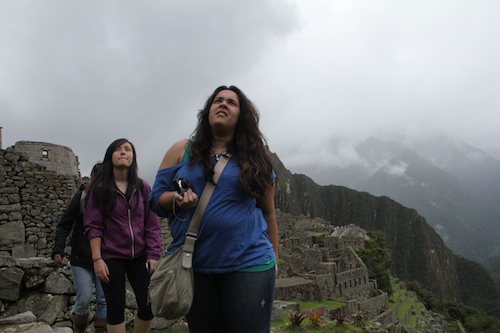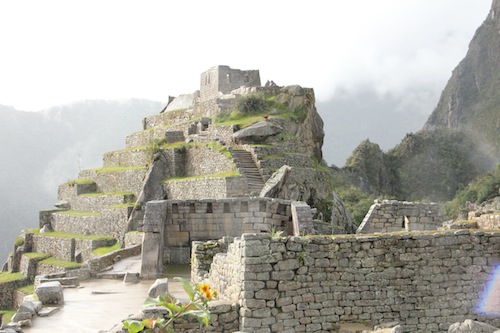The Shaman welcomes us in fluent Spanish. His skin looks like leather and his eyes laugh in their dark recesses. He must think we look funny, standing in a self-conscious semicircle before him. We swat flies, itch our sunburned arms and try to figure out what to do with the peels from the tangerines he gave us.
We finally toss them on the ground with the other husks, oil cans and plastic scraps torn to bits by the chickens and ducks stalking about. A little brown dog plops in the center of our awkward circle, scratching flees from its neck.
The Shaman swings his legs and sucks on his dentures while we formally introduce ourselves. He wears a red collared shirt, long sleeved. It’s buttoned near the top, and parts like a curtain below so we see his brown belly roll above his kaki shorts. Salsa music wafts up from a boom box down by the river. There’s the buzz of a TV from a hut nearby.
We will be making two fountain style sinks while we’re here. We see a few of a few archetypes scattered around the village. They’re magnificent, made of cobbled stones with brass fixtures.
Two parrots perch at the top of the stripped log structure that we’re all gathered inside. Behind this roofless frame the Amazon jungle stretches out in the misty green valley. There’s a rainbow connecting the vapor below to the billowing clouds above.
In four days we’ll be in Machu Picchu, and our tour guide will tell us that the rainbow is a sign of indigenous pride, a bridge from the mountains to the Milky Way. The vultures, gods of the sky, travel along it, carrying the souls of the dead to heaven, he’ll say.
For now we’ve reached the end of a two-day journey from Cuzco, ten hours on a bus along dirt roads, down from the mountains into the muddy foothills where the jungle begins. From there we took a hummer to the very end of civilization.
We traveled two hours from a dusty town where natives live in concrete bunkers, dry coca leaves on giant tarpaulins in the road, and hold lively protests against their poor living conditions outside of a public school beside the town hall.
We drove into the jungle, forded several rivers, to reach this village of clay huts collected at the edge of a massive valley. The electric wires end here, brought to the village by the government ten months ago. 70 percent of the power in Peru is hydroelectric. Around here water cascades down from the mountains, and it’s easy to harness.
Village’s reservoir was built in the side of one of the mountains 18 years ago, and it has a high-tech filtration system. The water that flows down is fresh, and cleaner then in most US cities. We can drink it right out of the tap.
We only have two days left in this village, and we’re just now meeting the Water Committee—the five odd villagers that act as emissaries for Yaku, the indigenous water project that UMB Beacon Voyages partnered with. We tour the village.
They’re in the midst of building a tourism industry, the project manager says. People like us want to come out to enjoy the natural beauty, but we don’t want to poo in the woods. He shows us a shower and a four-stall bathroom that he built last year, all polished stone. We take pictures of it. A donkey grazes near the septic system.
We want to prove that we’re worthwhile, so we begin carrying stones out to a Tambo, where we’re building the first fountain, and where we’ve already set up our tents for the night.
It’s a mile long hike, and as we walk the damp air dims. Thick raindrops begin pattering on the foliage above us. We huff and slip through the mud, ruining our sneakers.
At the Tambo it pours briefly but the setting sun comes out just in time for us to trek down to the river and bathe. We’re camped a few yards away from one of the inlets to the Amazon, on a twenty-foot tall cliff. We follow a path that’s been hacked through the jungle.
The foliage surrounds us like giant wet drapes, and suddenly it opens onto a sandy beach at a bend in the river. The water is clear, six feet deep in the center, and we see a few small fish shimmer in the dusk.
In the Tambo after dark, we eat our second full meal in the jungle. We have two cooks that travel with us and carry all of our food. Their work and their meals cost us less the $400 total, for the whole week, for thirteen of us. After dinner we drink Coca tea and reflect on our journey.
We wake up early. Our first full day of work runs us ragged, but we get more done than anyone on the Water Committee expected. We carry rocks from the river; dig a 25-foot drainage ditch into the clay soil; build the base of the fountain; pour the concrete sediment tank.
We’ve paid the men from the village to help us, and they do most of the digging. A few of them speak Spanish, and we ask what they do when they’re not entertaining tourists. One of them tells us about fishing, and catching trout as long as his arm. In the evening we swim in the river and wash off the mud that’s caked on our bodies.
The next day, our last full day in the village, a truck arrives to cart away a stack of massive lumber planks from somewhere in the rainforest. Maybe it’s wood cleared from one of their cornfields.
The truck puffs a plume of diesel smoke out over the rooftops as we trek into the village. We pass a Tambo with two motorbikes parked beneath it. The teenagers use these bikes to get to the high school, two hours out in that dusty town we stopped through. Everything travels in and out along one long dirt road.
We head hike to the site where we’re building the next fountain. We ford a river carrying bags of sand. We sweat profusely, and a few of our blisters pop in our boots and gloves.
That night the Shaman thanks us for finishing the two fountains we had promised them. His speech ends with a paraphrased translation from our guide, who chuckles awkwardly: “Whites bring water, electricity and create need. We can buy a refrigerator, a motorbike, a TV. Thank you! We never wanted that stuff before.”
This Shaman has traveled the world, and he speaks occasionally at conferences in Europe and at the UN. He is a voice for the native people in the Amazon who speak Ketchua and other dying languages. Clean water is fine, he says, but stop buying up the jungle that no one owns.
We ride out of the Amazon in a hurry the next day because of rain. Mudslides loom ahead, and we brave them. We arrive in Cusco 14 hours later, wet, cold and exhausted.
We eat McDonalds, because nothing else is open, and we go to bed dreaming of all the Alpaca sweaters that we will buy in the morning.






















































